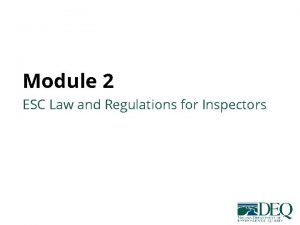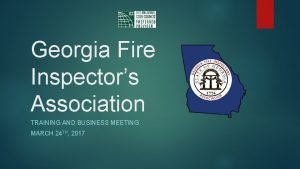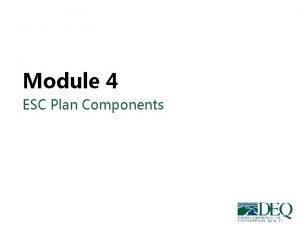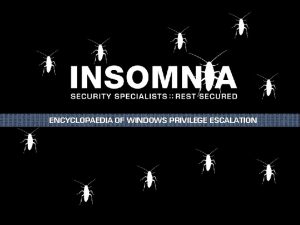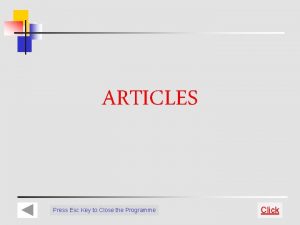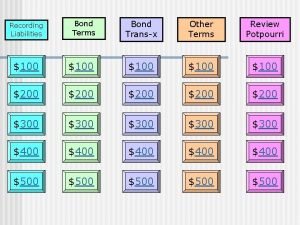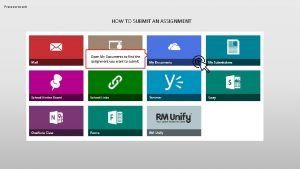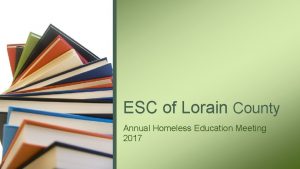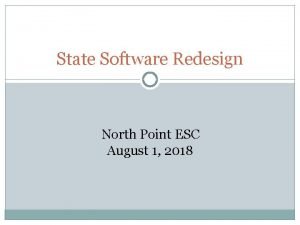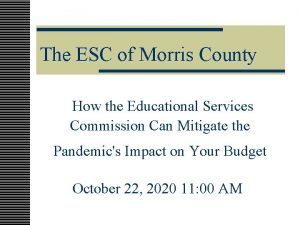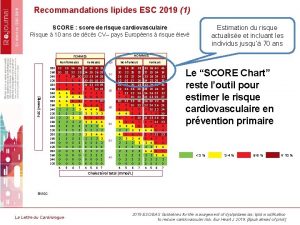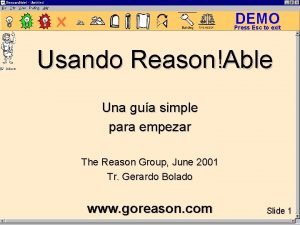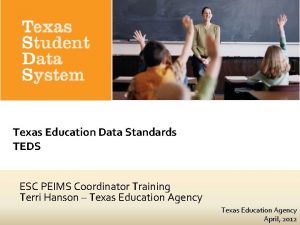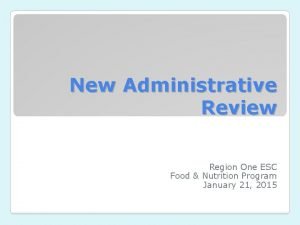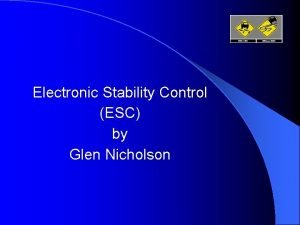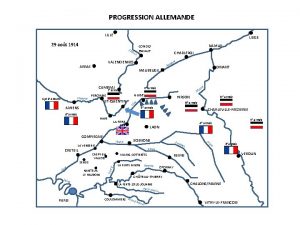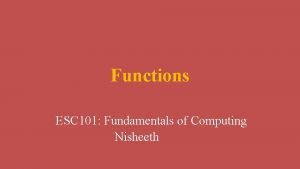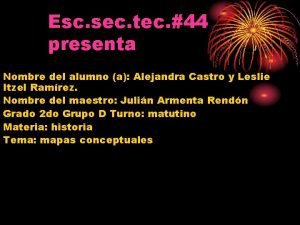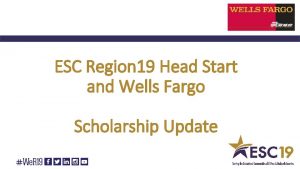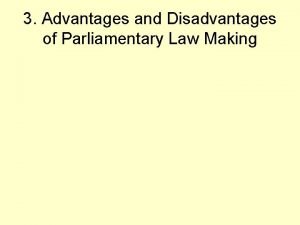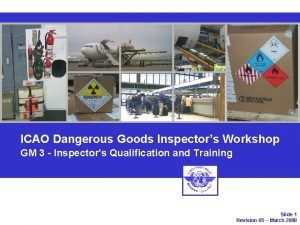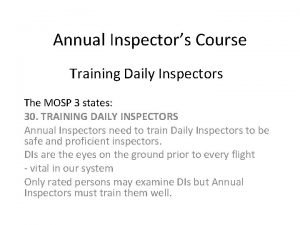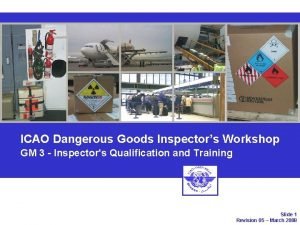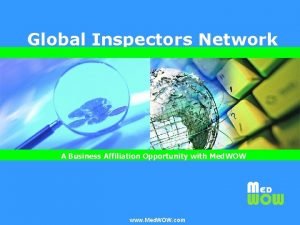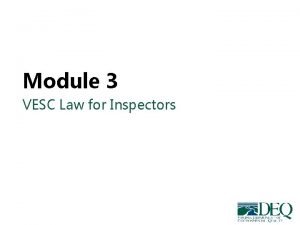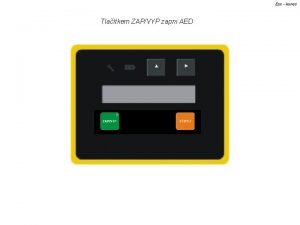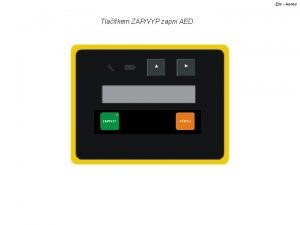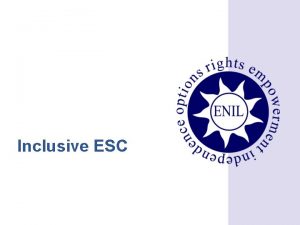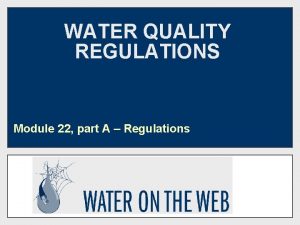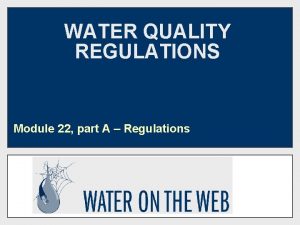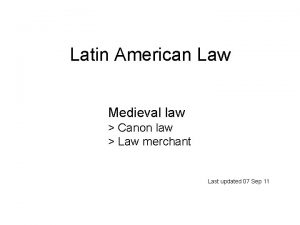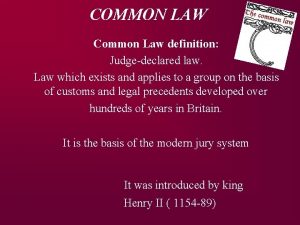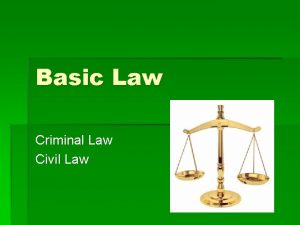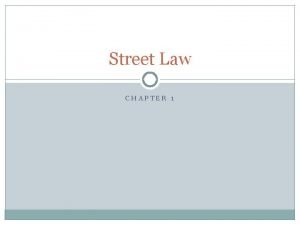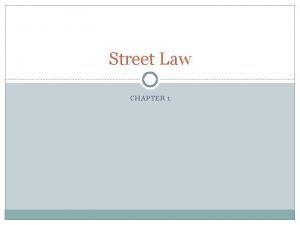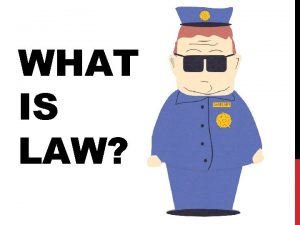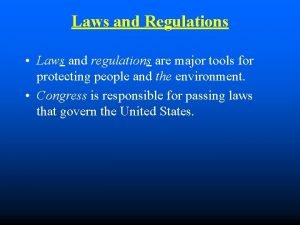Module 2 ESC Law and Regulations for Inspectors























































- Slides: 55

Module 2 ESC Law and Regulations for Inspectors

ESC in Virginia Law (§ 62. 1 -44. 15: 51 to § 62. 1 -44. 15: 66) Regulations (9 VAC 25 -840 -10 to 9 VAC 25 -840 -110) Module 2 Erosion and Sediment Control Program

Administrative Guidelines • Each ESC program must contain four elements (which are evaluated during the local ESC program review) • These components are: – Administration – Inspection* – Plan Review – Enforcement Module 2

Inspection Requirements • 62. 1 -44. 15: 58 -A – Requires inspections of land disturbing activities by program authority – Allows for monitoring reports to be submitted by the person responsible for the project (RLD) • 62. 1 -44. 15: 60 – Provides the right of entry by the Department or VESCP for inspection and enforcement Module 2

An Effective Inspection Program • An inspector must: – Posses an understanding of the rules established by state law, the regulations and the local ordinance – Organize a system to implement those rules effectively Module 2

Importance of Understanding the Law • A good understanding of the Law helps to effectively implement local ESC programs • Unless local officials act within the limits of the law, enforcement actions may become unsuccessful • Negligent or inappropriate application of an E&S program may even result in legal action against the Authority • Training local VESCP officials and experience will help improve local program consistency Module 2

The Inspector • The inspector must be “Certified” according to 62. 1 -44. 15: 51 (Definitions) and 62. 1 -44. 15: 53 (Certification of Local Program Personnel) Module 2

Role of the Inspector • During construction, the inspector is required to ensure that the land disturbing activity (the site) is in compliance with the approved plan and the minimum standards of the regulations. • Periodic inspections are required to be conducted on each land disturbing activity. Module 2

Inspection Frequency At the end of project During or after installation of perimeter controls Module 2 Every two weeks and within 48 hours of runoff producing rainfall event

Inspection Report • A form used to record a potential problem or violation; • A way to make sure the responsible person (job superintendent or RLD) is made aware of a problem; • Written documentation to help track the arguments or agreements made with the job superintendent; • A description of problem and advice on how and when it should be corrected. Module 2

Inspection Report • Inspections need to be documented! • If it isn’t in writing it didn’t happen! Module 2

Inspection Report • Inspection reports serve as notice of either noncompliance or compliance • Issues of non-compliance must have a deadline for correction Module 2

Inspections • Inspections should be done with the following items in mind: – Does the project comply with the Minimum Standards? – Does the project comply with the standards and specifications in the ESC Handbook? (or an approved variance or other local requirements) – Is the project being constructed in accordance with the approved plan? Module 2

The Objective of Inspections • Does the project/regulated land disturbance activity meet the requirements of: – ESC Law – ESC Regulations – Local ordinances – Virginia Erosion and Sediment Control Handbook – Approved ESC plan Module 2

Changes to Approved ESC Plan • Plan changes may be required when: – Inspection reveals inadequacies – Change in circumstances, so approved ESC plan no longer effective • All changes must be consistent with law, regulations, and specifications Module 2

Variances Request • At time of plan submittal • During construction when field conditions/situations changes • Must be in writing • Cannot be granted for economic reasons Review • Auto-denial after 10 days • Must be judicious Module 2

Alternative Inspection Program • Ensures compliance with the approved erosion and sediment control plan. – Approved by the Board prior to implementation; – Established in writing; – Based upon a system of priorities that, at a minimum, address the amount of disturbed area, site conditions and stage of construction; and – Documented by inspection records Module 2

Photographs • Court action may take a long time and situation in the field may change • Enforcement action may be more effective • Take before photographs • Take pictures of environmentally sensitive areas, adjacent areas, downstream areas • Take photographs of final stabilization conditions Module 2

Enforcement The Process of Compliance

Documentation • Document each inspection in writing (example report on DEQ website). • Record whether or not a possible violation is found. • The more documentation the better in case of a court case or further enforcement actions. • Photographs taken will help clarify inspection reports. Module 2

Compliance Formula Proper construction of controls at the right time Module 2 Proper maintenance of controls Effective sediment control

Notice to Comply • Served upon permittee if locality VESCP authority or DEQ determines failure to comply with – approved ESC plan, – minimum standards, or – failure to properly install or maintain ESC measures Module 2

Notice to Comply • Served by either: – Mailing with conformation of delivery to address in permit application or in plan certification – Delivery at the site of the land-disturbing activity to the agency or employee supervising activities Module 2

Notice to Comply • Must specify: – Measures needed to comply with the approved ESC plan – Time within which such corrective measures shall be completed Module 2

Failure to Comply • Upon failure to comply within time specified: Local land disturbance permit Module 2 Penalties, injunctions, other legal actions

Stop Work Order • Issued by the VESCP authority or DEQ in the following three scenarios, after an inspection report denotes a violation Module 2

Stop Work Order – Scenario 1 • Failure to comply with an ESC plan Deadline not met Inspection Report Module 2 Notice to Comply

Stop Work Order – Scenario 1 • How to deliver: – Hand-deliver at the site of the LDA or – Mail stop work order, with confirmation of delivery, to the address specified in the permit application or plan certification Module 2

Stop Work Order – Scenario 1 • LDA must stop on all or part of the site until specific corrective measures listed in the notice to comply are taken • Stop work order remains in effect for 7 days from the date of service • If corrective actions are completed sooner, the stop work order may be lifted Module 2

Stop Work Order – Scenario 2 • LDA started without an approved ESC plan or required permits No Approved Plan Module 2

Stop Work Order – Scenario 2 • How to issue: – Mail with confirmation of delivery to the address specified in the land records of the locality and – Post on the site where the disturbance is occurring Module 2

Stop Work Order – Scenario 2 • LDA must stop on the entire site • Order remains in effect until an ESC plan is approved and required permits are obtained Module 2

Stop Work Order – Scenario 3 • Alleged noncompliance is causing, or is in imminent danger of causing, harmful erosion of lands or sediment deposition in waters within the watersheds of the Commonwealth Imminent Danger Module 2

Stop Work Order – Scenario 3 • Remains in effect for 7 days from date of service • If corrective actions are completed sooner, stop work order may be lifted Module 2

Stop Work Order – Scenario 3 After issuing an emergency stop work order, DEQ must provide an opportunity for a hearing, after reasonable notice as to the time and place thereof, to such person, to affirm, modify, amend, or cancel such emergency order. Module 2

Appealing a Stop Work Order • Property owner may appeal issuance of a stop work order to the circuit court of the jurisdiction wherein violation was alleged to have occurred or other appropriate court Module 2

State Agency Projects • 62. 1 -44. 15: 56 -F – Makes state agency responsible for compliance with approved plans • 62. 144. 15: 56 -G – Makes state and federal agencies responsible for plan review and inspections with DEQ’s oversight, enforcement, compliance review and evaluation Module 2

Construction General Permit • Projects disturbing land equal to or greater than 1 acre must have coverage under the Virginia Construction General Permit (CGP) Module 2

Pollution Prevention (P 2) Plan • Each project must have a SWPPP on site that includes a P 2 (Pollution Prevention Plan) • P 2 plan is dynamic, “living” document that addresses other forms of potential pollution during construction • Potential pollutant sources/activities and P 2 practices may change over time Module 2

Pollution Prevention (P 2) Plan • The P 2 plan changes as site conditions change. • The operator is responsible for updating the P 2 plan. Module 2

Pollution Prevention (P 2) Plan • Must: – Potential pollutants and their location – Describe location of potential pollutant-generating activities (Can reference the site plan) – Identify all authorized non-stormwater discharges that will be commingled with stormwater discharges – Identify the person responsible for implementing the pollution prevention practice or practices for each pollutant-generating activity (If other than the person listed as the qualified personnel) Module 2

Pollution Prevention (P 2) Plan e. Describe pollution prevention practices and procedures that will be implemented to: 1) Prevent and respond to leaks, spills, and other releases Module 2

Pollution Prevention (P 2) Plan e. Describe pollution prevention practices and procedures that will be implemented to: 2) Prevent the discharge of spilled and leaked fuels and chemicals from vehicle fueling and maintenance activities Module 2

Mobile Fueling

Pollution Prevention (P 2) Plan e. Describe pollution prevention practices and procedures that will be implemented to: 3) Prevent the discharge of soaps, solvents, detergents, and wash water from construction materials Module 2

Pollution Prevention (P 2) Plan e. Describe pollution prevention practices and procedures that will be implemented to: 4) Minimize the discharge of pollutants from vehicle and equipment washing, wheel wash water, and other types of washing Module 2

Pollution Prevention (P 2) Plan • Good housekeeping tips: – Wash offsite at an appropriate facility – Locate away from storm drain inlets, drainage facilities and waterways – Use filtration and settling devices to remove sediments – Direct wash waters to basins, traps or other suitable BMPs Module 2

Pollution Prevention (P 2) Plan Remember, no discharge of soaps, solvents or detergents ! Module 2

Pollution Prevention (P 2) Plan e. Describe pollution prevention practices and procedures that will be implemented to: 5) Direct concrete wash water into a leak-proof container or leak-proof settling basin Module 2

Pollution Prevention (P 2) Plan • Container or basin cannot overflow • Hardened and liquid concrete waste must be removed and properly disposed • www. epa. gov/npdes/pubs /concretewashout. pdf Module 2

Pollution Prevention (P 2) Plan e. Describe pollution prevention practices and procedures that will be implemented to: 6) Minimize the discharge of pollutants from storage, handling, and disposal of construction products, materials, and wastes Module 2

Pollution Prevention (P 2) Plan Module 2

Pollution Prevention (P 2) Plan e. Describe pollution prevention practices and procedures that will be implemented to: 7) Prevent the discharge of fuels, oils, and other petroleum products, hazardous or toxic wastes, and sanitary wastes Module 2

Pollution Prevention (P 2) Plan e. Describe pollution prevention practices and procedures that will be implemented to: 8) Address any other discharge from the potential pollutantgenerating activities Module 2

Pollution Prevention (P 2) Plan f. Describe procedures for providing pollution prevention awareness to personnel in order to comply with the conditions of the permit Module 2
 Esc law
Esc law Georgia fire investigators association
Georgia fire investigators association Food laws in pakistan
Food laws in pakistan Food inspectors series 2 episode 2
Food inspectors series 2 episode 2 Worcester ma inspectional services
Worcester ma inspectional services Newton's first law and second law and third law
Newton's first law and second law and third law Newton's first law of motion
Newton's first law of motion V=k/p
V=k/p Charles law constant
Charles law constant Esc router
Esc router Esc 18
Esc 18 Windows priv esc
Windows priv esc Esc la neuveville vacances
Esc la neuveville vacances Esc
Esc Region one esc
Region one esc Transx esc
Transx esc Press esc to exit
Press esc to exit Esc of lorain county
Esc of lorain county Wms la neuveville
Wms la neuveville Region one esc
Region one esc North point esc
North point esc Projet esc
Projet esc Esc of morris county
Esc of morris county Score esc 2019
Score esc 2019 Press esc to exit
Press esc to exit Trumbull county esc
Trumbull county esc Texas education data standards
Texas education data standards Region 1 esc
Region 1 esc What is esc
What is esc Lille liege
Lille liege Esc 101
Esc 101 Sec tec 44
Sec tec 44 Esc region 19 head start
Esc region 19 head start C device module module 1
C device module module 1 Disadvantages of act of parliament
Disadvantages of act of parliament Iso 22301 utbildning
Iso 22301 utbildning Typiska novell drag
Typiska novell drag Tack för att ni lyssnade bild
Tack för att ni lyssnade bild Ekologiskt fotavtryck
Ekologiskt fotavtryck Shingelfrisyren
Shingelfrisyren En lathund för arbete med kontinuitetshantering
En lathund för arbete med kontinuitetshantering Kassaregister ideell förening
Kassaregister ideell förening Tidbok
Tidbok Anatomi organ reproduksi
Anatomi organ reproduksi Vad är densitet
Vad är densitet Datorkunskap för nybörjare
Datorkunskap för nybörjare Boverket ka
Boverket ka Debatt artikel mall
Debatt artikel mall Magnetsjukhus
Magnetsjukhus Nyckelkompetenser för livslångt lärande
Nyckelkompetenser för livslångt lärande Påbyggnader för flakfordon
Påbyggnader för flakfordon Lufttryck formel
Lufttryck formel Svenskt ramverk för digital samverkan
Svenskt ramverk för digital samverkan Kyssande vind analys
Kyssande vind analys Presentera för publik crossboss
Presentera för publik crossboss Vad är ett minoritetsspråk
Vad är ett minoritetsspråk
